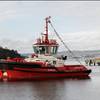ITIC Highlights Importance of Vessel Design Reviews Following $5 Million Claim
The International Transport Intermediaries Club (ITIC) has highlighted the importance of robust vessel design reviews and related insurance coverage throughout the construction process following a recent dispute between a naval architect, a shipowner and a shipyard regarding a vessel’s operational performance post-delivery.
The vessel, a 24-metre catamaran servicing the offshore oil and gas industry, faced considerable operational limitations. This was attributed to unexpected vibration issues in the vessel's rudders, leading to hull stress and subsequent structural cracking.
Despite the naval architect's best efforts to solve the problem and the shipowner and shipyard's collaboration to rectify the causes through various modifications, no significant reduction in vibration was achieved.
Upon further investigation, it was discovered that the vibrations in the rudders were caused by cavitation due to the original propeller designs. Cavitation is the formation of bubbles from a nearby moving blade, such as the propeller, which results in the pitting of the rudder and/or blades' surface.
Despite the naval architect's proposal to change the propellers, which was covered by ITIC, the modifications only marginally decreased the vibrations, and the vessel still failed to meet its intended speed and performance specifications.
After analyzing the situation, third-party experts concluded that the most likely cause of the problem was the insufficient clearance between the propellers' tips and the vessel, which resulted from the original design by the naval architect. However, the experts also recommended replacing the rudders and correcting the rudder support structure, as it was found that the rudder support structure was not constructed according to the naval architect's design. This needed to be rectified before it was worthwhile moving the propellers.
The vessel’s owners faced operational and financial problems as a result of these issues and took legal action against both the naval architect and shipyard. They sought damages for rectification costs, loss of earnings, diminution in the vessel's value, and other related expenses. As a result, they filed a claim of US$5 million plus legal costs and interest.
Following a long legal process that involved challenges in obtaining expert evidence to support the claim, all parties opted for mediation. Due to limited personal funds and policy coverage limits, the naval architect agreed to a settlement contribution of US$400,000, indemnified by ITIC. This amount represented less than 10% of the original claim.
Mark Brattman, Claims Director at ITIC, said: “The agreement reached between the parties involved in the dispute not only resolved the matter at hand but also emphasized the intricate interdependencies involved in maritime design and construction. It highlights the significance of conducting a thorough design review, and, where possible, making sure the builders adhere to the design specifications.
“It is important for the designer to have insurance coverage in place to manage the risks that come with maritime design. The designer potentially faces claims from both the end user and the shipyard if the vessel fails to perform. The costs of defense, even if the designer hasn’t made an error, can be incredibly high. Proper insurance can help the designer rest easy.
“Our advice to members is to review their internal protocols and procedures to reduce the likelihood of similar errors not being spotted in the future and to ensure they have sufficient insurance cover, thereby mitigating the risks of potential losses and legal costs,” Brattman concluded.














